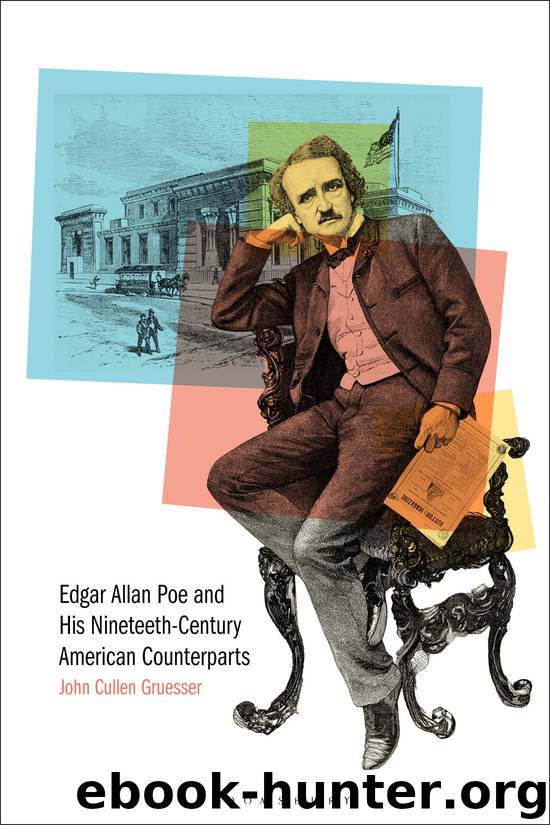Edgar Allan Poe and His Nineteenth-Century American Counterparts by John Cullen Gruesser;

Author:John Cullen Gruesser;
Language: eng
Format: epub
Publisher: Bloomsbury USA
6
Madness, Mystification, and “Average Racism” in “The Gold-Bug,” E. D. E. N. Southworth’s The Hidden Hand, Harriet Jacobs’s Incidents in the Life of a Slave Girl, and Pauline Hopkins’s Hagar’s Daughter
Why, to be frank, I felt somewhat annoyed by your evident suspicions touching my sanity, and so resolved to punish you quietly, in my own way, by a little bit of sober mystification.
Poe, “The Gold-Bug”
“This convict, as you are aware, is a man of consummate cunning. . . .” “Ah, but . . . his cunning was no match for mine, you know!” said Capitola, smiling.
E. D. E. N. Southworth, The Hidden Hand
I knew his cunning nature too well not to perceive that this was a trap laid for me. . . . I resolved to match my cunning against his cunning.
Harriet Jacobs, Incidents in the Life of a Slave Girl
It’s as sure as preaching that somebody who knows something must take hold of Miss Jewel’s case or that son of Sodom will carry his point. . . . I’ll see if this one little black girl can’t get the best of as mean a set of villains as ever was born. . . .
Pauline Hopkins, Hagar’s Daughter: A Story of Southern Caste Prejudice
A century separates the manumitted slave Jupiter, who does not know his left from his right in “The Gold-Bug,” and the black “day houseman” Sam in Cornell Woolrich’s “It Had to Be Murder” (1942), the source for Alfred Hitchcock’s celebrated 1954 film Rear Window. Yet these characters resemble each other in striking ways. Each is a superstitious, dialect-speaking, older African American male ordered, without explanation, to undertake a dangerous ascent in the seemingly whimsical pursuit of the solution to a mystery by his incapacitated white employer—the putatively insane William Legrand in Poe’s story and the cast-ridden Jeff (Hal Jeffries) in Woolrich’s. Significantly, Jeff’s servant, who would be transmogrified into the wealthy socialite Lisa Fremont played by Grace Kelly in Rear Window, bears the same name as the ex-slave in Thomas Nelson Page’s influential plantation story “Marse Chan” (1884). Such continuity in the portrayal of black characters in fiction by white American authors makes all the more noteworthy mid-nineteenth- and turn-of-the-twentieth-century black texts that not only denounce slavery and depict its horrors but also counter-discursively respond to the pervasive marginalization and stereotyping of African Americans in literary and popular culture.
In “The Gold-Bug,” Poe explicitly introduces the theme of race into detective fiction. Apart from the sensation created by “The Raven” in 1845, he achieved the most notoriety during his lifetime with this ratiocinative tale about a coded map leading to pirate treasure, which won the first prize of $100 in a contest sponsored by the Dollar Newspaper of Philadelphia. After first appearing in that publication in June 1843, it was reprinted later that year and often thereafter in American newspapers (without any additional compensation for Poe). A pirated version was brought out in England in 1846 or 1847, and French, German, and Russian translations of the story were published before 1850.
Download
This site does not store any files on its server. We only index and link to content provided by other sites. Please contact the content providers to delete copyright contents if any and email us, we'll remove relevant links or contents immediately.
4 3 2 1: A Novel by Paul Auster(11761)
The handmaid's tale by Margaret Atwood(7423)
Giovanni's Room by James Baldwin(6778)
Asking the Right Questions: A Guide to Critical Thinking by M. Neil Browne & Stuart M. Keeley(5338)
Big Magic: Creative Living Beyond Fear by Elizabeth Gilbert(5325)
Ego Is the Enemy by Ryan Holiday(4922)
On Writing A Memoir of the Craft by Stephen King(4647)
The Body: A Guide for Occupants by Bill Bryson(4560)
Ken Follett - World without end by Ken Follett(4427)
Bluets by Maggie Nelson(4244)
Adulting by Kelly Williams Brown(4213)
Eat That Frog! by Brian Tracy(4128)
Guilty Pleasures by Laurell K Hamilton(4098)
White Noise - A Novel by Don DeLillo(3818)
The Poetry of Pablo Neruda by Pablo Neruda(3797)
Fingerprints of the Gods by Graham Hancock(3719)
Alive: The Story of the Andes Survivors by Piers Paul Read(3714)
The Book of Joy by Dalai Lama(3675)
The Bookshop by Penelope Fitzgerald(3608)
